In today’s fast-paced digital landscape, businesses must be agile to thrive. A crucial step in achieving this agility is cloud migration. This process can unlock incredible potential for your organization, empowering you to scale your operations, innovate faster, and adapt to changing market demands. By moving your infrastructure and applications to the cloud, you can break free from the constraints of traditional on-premises systems and embrace a world of scalability, flexibility, and cost-effectiveness.
However, cloud migration can seem daunting. With so many cloud providers and migration strategies available, it’s hard to know where to start. This comprehensive guide will walk you through the entire process, providing a step-by-step plan to help you navigate the complexities of cloud migration and unlock the true potential of your business. From assessing your needs to choosing the right cloud platform and executing a seamless transition, we’ll equip you with the knowledge and tools needed to make your cloud migration a success.
The Business Case for Cloud Migration: Benefits and Opportunities
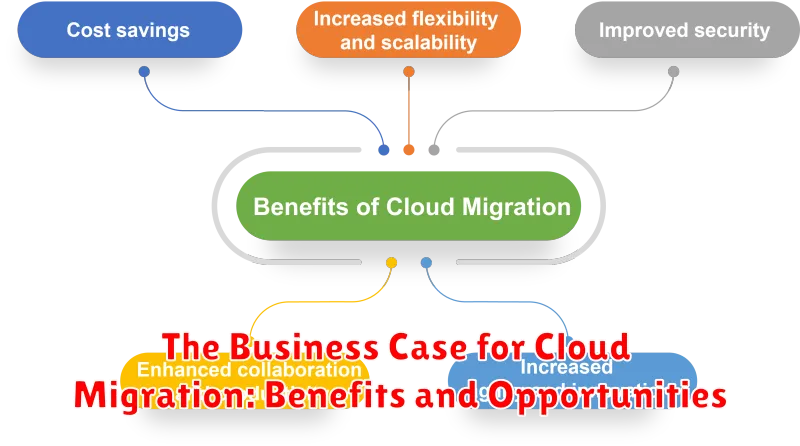
In today’s fast-paced business environment, agility is key to success. Companies need to be able to adapt quickly to changing market conditions, customer demands, and technological advancements. Cloud migration offers a powerful solution, enabling businesses to unlock a wealth of benefits and opportunities that drive agility and enhance competitiveness.
The business case for cloud migration is compelling. By transitioning to the cloud, organizations can reap numerous advantages, including:
Increased Agility and Scalability
Cloud computing provides unparalleled flexibility and scalability. Businesses can quickly provision resources, scale up or down as needed, and respond to fluctuations in demand without the constraints of traditional infrastructure. This agility allows companies to launch new products and services faster, enter new markets, and seize opportunities more effectively.
Cost Optimization
Cloud migration can significantly reduce IT costs. By shifting to a pay-as-you-go model, companies only pay for the resources they actually use, eliminating the need for upfront investments in hardware, software, and maintenance. This cost optimization frees up capital for innovation and growth.
Enhanced Security
Cloud providers invest heavily in security infrastructure and expertise. By leveraging cloud services, organizations can benefit from robust security measures, including data encryption, access controls, and disaster recovery capabilities, enhancing data protection and reducing the risk of breaches.
Improved Collaboration and Productivity
Cloud-based platforms foster collaboration and productivity. Employees can access applications, data, and resources from anywhere, anytime, using any device. This facilitates seamless teamwork, reduces communication barriers, and empowers individuals to work more efficiently.
Innovation and Growth
The cloud provides a platform for innovation. Access to cutting-edge technologies, such as artificial intelligence (AI), machine learning (ML), and big data analytics, empowers businesses to develop new products, services, and business models, driving growth and differentiation.
By embracing cloud migration, businesses can unlock a range of benefits and opportunities that drive agility, optimize costs, enhance security, improve collaboration, and foster innovation. The compelling business case for cloud migration makes it a strategic imperative for organizations seeking to thrive in today’s dynamic landscape.
Understanding Different Cloud Migration Strategies: IaaS, PaaS, SaaS
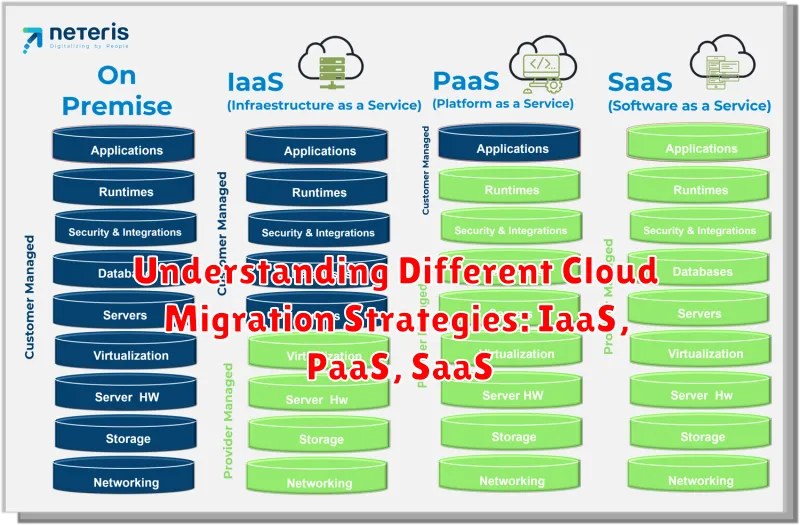
The cloud has become an integral part of modern businesses, offering flexibility, scalability, and cost-effectiveness. However, transitioning from traditional on-premises infrastructure to the cloud requires careful planning and strategy. Understanding the various cloud migration strategies is crucial to achieving a successful and seamless transition. One key aspect to consider is the cloud service model you choose: Infrastructure as a Service (IaaS), Platform as a Service (PaaS), or Software as a Service (SaaS).
IaaS provides you with the fundamental building blocks of cloud computing, such as virtual machines, storage, and networking. You have complete control over your infrastructure and can customize it to your specific needs. This model offers greater flexibility but also requires more technical expertise and management.
PaaS takes the concept of IaaS a step further by offering a platform for developing, running, and managing applications. It provides pre-configured environments, development tools, and databases, simplifying application development and deployment. You don’t need to manage the underlying infrastructure, focusing on your application logic.
SaaS delivers software applications over the internet, allowing you to access and utilize them without needing to install or manage any software on your own servers. This model offers the highest level of abstraction, providing ready-to-use applications with minimal setup and maintenance. You only need to manage user accounts and data within the application itself.
The choice between these cloud service models depends on your specific business needs and technical capabilities. Consider factors like your existing IT infrastructure, desired level of control, and budget when making your decision.
Assessing Your Cloud Readiness: Key Considerations Before Migrating
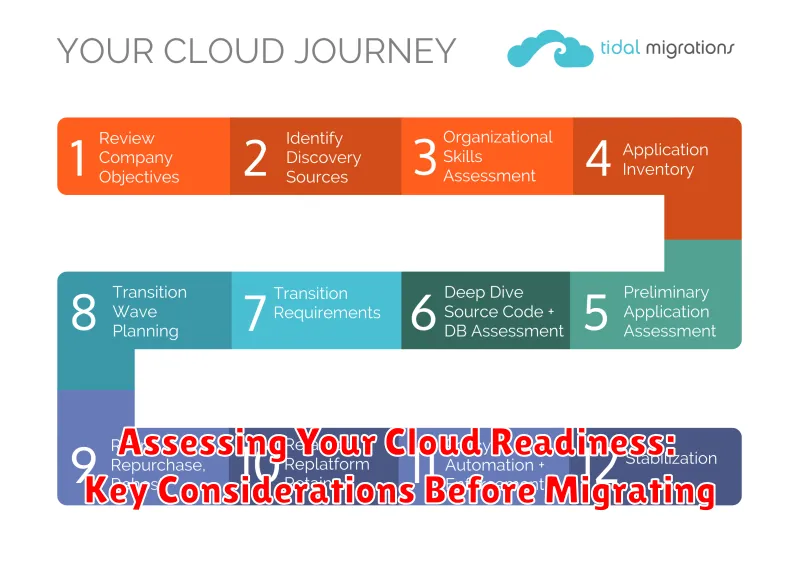
Migrating to the cloud can unlock tremendous business agility, but it’s crucial to ensure you’re prepared for the journey. Before diving in, a thorough assessment of your cloud readiness is essential. This involves examining your current infrastructure, applications, and organizational capabilities to determine if you’re well-positioned for a successful cloud migration.
Key Considerations for Cloud Readiness:
Here are some critical factors to evaluate before embarking on your cloud migration:
- Business Objectives: Clearly define your goals for cloud adoption. What problems are you trying to solve? How will the cloud help you achieve your business objectives?
- Application Compatibility: Analyze your existing applications to ensure they are compatible with cloud environments. Consider factors like operating systems, dependencies, and integration requirements.
- Data Security and Compliance: Develop a robust data security strategy and ensure compliance with relevant regulations. Cloud providers offer various security features, but it’s essential to understand their capabilities and limitations.
- Cost Optimization: Conduct a detailed cost analysis to understand the potential savings and expenses associated with cloud migration. Consider factors like licensing, storage, and usage fees.
- Technical Expertise: Evaluate your team’s skills and experience with cloud technologies. You may need to hire or train personnel to support your cloud migration and ongoing management.
- Cloud Provider Selection: Research different cloud providers and their offerings, including pricing, features, support, and service level agreements. Choose the provider that best aligns with your business needs.
By carefully assessing your cloud readiness, you can mitigate potential risks, optimize your migration strategy, and maximize the benefits of cloud adoption.
Developing a Comprehensive Cloud Migration Plan

Migrating to the cloud is a strategic decision that requires a well-defined plan to ensure a smooth and successful transition. A comprehensive cloud migration plan outlines the steps, resources, and timelines involved in moving your applications, data, and infrastructure to the cloud. It’s an essential blueprint for achieving your desired business outcomes and maximizing the benefits of cloud adoption.
Here’s a step-by-step guide to developing a comprehensive cloud migration plan:
1. Define Your Business Objectives and Goals
Before embarking on your cloud migration journey, clearly define your business objectives. What do you hope to achieve by migrating to the cloud? Is it about increasing agility, reducing costs, enhancing scalability, or improving security? Aligning your migration plan with your business goals ensures you choose the right cloud services and strategies to meet your specific needs.
2. Conduct a Thorough Assessment
A comprehensive assessment is crucial to understand your current IT environment and identify the applications, data, and infrastructure that will be migrated. This assessment should consider factors such as application dependencies, data volumes, security requirements, and potential risks.
3. Choose the Right Cloud Provider and Services
The cloud landscape offers a wide range of providers and services. Research and evaluate different options based on factors like pricing, security, compliance, support, and integration capabilities. Consider your business requirements, budget constraints, and long-term goals when making this decision.
4. Develop a Migration Strategy
Based on your assessment and cloud provider selection, develop a migration strategy that outlines the approach, methodology, and tools for migrating your applications and data. Popular migration strategies include lift and shift, re-platforming, and re-architecting. Choose the strategy that best aligns with your business objectives and technical constraints.
5. Plan for Data Migration
Data migration is a critical aspect of the process. Ensure you have a robust plan for migrating your data to the cloud, considering factors such as data volume, security, and data integrity. Utilize appropriate data migration tools and techniques to ensure a seamless and secure transfer.
6. Test and Validate
Thorough testing is essential to validate the functionality, performance, and security of your migrated applications and data in the cloud environment. Conduct various tests, including functional, load, and security testing, to identify and resolve any potential issues before going live.
7. Implement and Monitor
Once your migration plan is validated, start the implementation process. Monitor your applications and infrastructure closely to identify and address any performance or security issues. Continuous monitoring ensures optimal performance and helps you adapt to changing business needs.
8. Optimize and Refine
Cloud migration is an ongoing journey. Continuously optimize your cloud environment by leveraging cloud services, automation tools, and best practices to maximize efficiency and cost savings. Regularly review and refine your migration plan to adapt to evolving business requirements and technological advancements.
Choosing the Right Cloud Provider for Your Business Needs
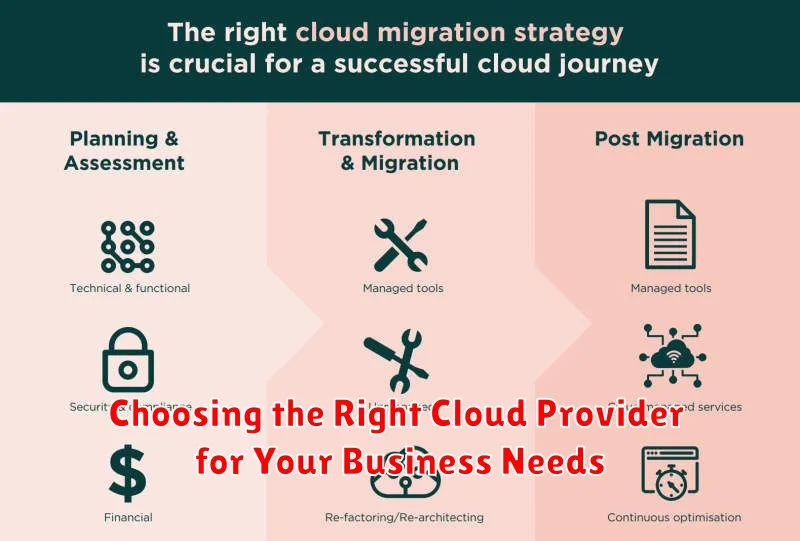
Choosing the right cloud provider is a crucial step in your cloud migration journey. It’s not a one-size-fits-all decision, as different providers offer diverse services and features. To make the best choice for your business, consider these factors:
1. Services and Features: Determine your specific cloud needs. Do you require Infrastructure as a Service (IaaS), Platform as a Service (PaaS), or Software as a Service (SaaS)? Evaluate providers based on their offerings and whether they align with your business goals.
2. Security and Compliance: Security is paramount. Choose a provider with robust security measures, compliance certifications (e.g., ISO 27001, HIPAA), and data encryption capabilities to safeguard your sensitive information.
3. Scalability and Flexibility: Select a provider that can scale with your evolving needs. Look for flexible solutions that allow you to adjust resources and services as your business grows.
4. Pricing and Cost-Effectiveness: Compare pricing models, including pay-as-you-go, reserved instances, and spot instances. Analyze the overall cost-effectiveness and potential savings compared to on-premises solutions.
5. Customer Support and Documentation: Ensure the provider offers excellent customer support, comprehensive documentation, and training resources to assist with any challenges or issues.
6. Industry Expertise: Consider providers with experience in your industry. They can offer valuable insights and best practices for optimizing your cloud environment.
By carefully evaluating these factors, you can choose the cloud provider that best supports your business needs and unlocks the full potential of your cloud migration journey.
Data Migration Best Practices for a Seamless Transition

Data migration is a crucial process in any cloud migration journey. It involves moving your data from an on-premises system or legacy cloud to a new cloud environment. While this is a necessary step, it can be complex and challenging if not properly planned and executed. To ensure a seamless transition, implementing best practices is essential.
Here are some key considerations for a successful data migration:
1. Plan Thoroughly and Define Scope
A well-defined plan is the foundation of a successful migration. You need to clearly define the scope of the migration, including the data to be migrated, the source and target systems, and the timeline. A thorough assessment of your data, including its volume, structure, and dependencies, will help you create a realistic plan.
2. Choose the Right Migration Approach
There are various migration approaches, each with its advantages and disadvantages. Common methods include:
- Lift and Shift: Moving your entire application and data to the cloud without significant changes.
- Replatforming: Making some changes to the application or data to optimize it for the cloud.
- Re-architecting: Completely redesigning your application and data for the cloud.
The best approach depends on your specific needs and goals.
3. Test, Test, Test
Thorough testing is crucial to ensure data integrity and prevent issues during and after the migration. Conduct multiple tests, including data validation, performance testing, and disaster recovery drills, to identify and resolve potential problems before going live.
4. Secure Your Data
Data security is paramount during migration. Ensure you have appropriate security measures in place throughout the process, including data encryption, access controls, and disaster recovery plans.
5. Get Expert Help
If you lack the in-house expertise, consider partnering with cloud migration specialists. Experienced professionals can provide valuable guidance, manage complex tasks, and ensure a smooth transition.
By adhering to these data migration best practices, you can significantly minimize risks and ensure a successful and seamless transition to the cloud.
Application Modernization in the Cloud

Application modernization is the process of updating and enhancing existing applications to take advantage of new technologies and improve performance, scalability, and security. The cloud provides an ideal environment for application modernization, offering a range of benefits that can help organizations unlock business agility and drive innovation.
Here are some key aspects of application modernization in the cloud:
Refactoring and Re-architecting
This involves restructuring the application code and architecture to improve performance, scalability, and maintainability. It can involve migrating to cloud-native services, containerization, and microservices architectures.
Cloud-Native Technologies
Cloud-native technologies, such as serverless computing, containerization, and microservices, enable organizations to build and deploy applications faster and more efficiently. These technologies allow for greater scalability, flexibility, and resilience.
Data Migration and Optimization
Moving data to the cloud requires careful planning and execution. Data migration tools and services can help streamline the process, and cloud databases can provide enhanced performance and scalability for data storage and management.
Security and Compliance
The cloud offers a range of security features that can help organizations protect their applications and data. However, it’s essential to choose a cloud provider with strong security practices and to implement appropriate security measures to ensure compliance with relevant regulations.
Benefits of Application Modernization in the Cloud
Modernizing applications in the cloud offers significant benefits, including:
- Increased Agility: Cloud-native architectures and technologies allow for faster development and deployment cycles.
- Improved Scalability: Cloud resources can be easily scaled up or down to meet changing business needs.
- Enhanced Performance: Cloud platforms provide high-performance computing resources and optimized infrastructure.
- Reduced Costs: Cloud services can help reduce operational costs by eliminating the need for on-premises infrastructure.
- Increased Innovation: Access to cloud-native technologies and services enables organizations to explore new ideas and solutions.
Overall, application modernization in the cloud is a strategic initiative that can unlock business agility, drive innovation, and help organizations stay ahead of the competition.
Ensuring Cloud Security and Compliance During and After Migration
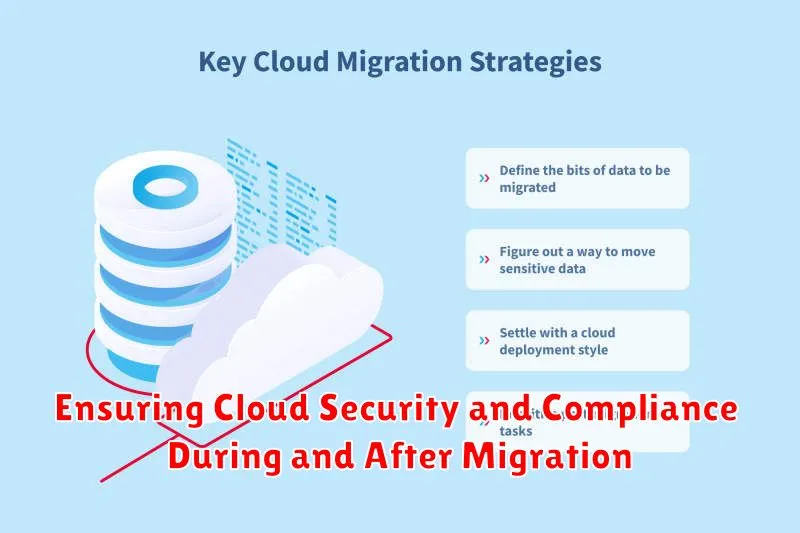
Migrating to the cloud unlocks a world of possibilities for businesses, but it also presents unique security and compliance challenges. From protecting sensitive data to adhering to industry regulations, ensuring robust security measures is crucial throughout the entire migration journey.
Here’s a step-by-step guide to prioritize security and compliance during and after your cloud migration:
1. Conduct a Thorough Security Assessment
Start by evaluating your current security posture and identifying potential vulnerabilities. This assessment should cover everything from your existing infrastructure and data to your security policies and procedures. A comprehensive assessment will help you understand the risks associated with migrating to the cloud and develop appropriate mitigation strategies.
2. Choose the Right Cloud Provider
Not all cloud providers are created equal. Thoroughly research and select a provider that aligns with your security and compliance requirements. Consider their security certifications, compliance frameworks (like ISO 27001, SOC 2, HIPAA, and GDPR), and data center security measures.
3. Implement Strong Access Controls
Secure access to your cloud environment is paramount. Implement multi-factor authentication (MFA) for all user accounts and restrict access based on the principle of least privilege. Regularly review and update your access control policies to minimize the risk of unauthorized access.
4. Encrypt Data at Rest and in Transit
Encryption is essential for protecting sensitive data. Ensure that all data stored in the cloud is encrypted at rest, and use TLS/SSL to encrypt data in transit. Implement data loss prevention (DLP) measures to prevent unauthorized data exfiltration.
5. Implement a Robust Security Monitoring and Logging Strategy
Actively monitor your cloud environment for suspicious activity. Implement a comprehensive logging system to capture all events and ensure you have visibility into your cloud infrastructure. Utilize security information and event management (SIEM) tools to detect and respond to threats in real-time.
6. Develop a Disaster Recovery and Business Continuity Plan
Plan for the unexpected. Develop a robust disaster recovery plan that outlines how you will recover from data breaches, outages, or other incidents. Ensure your plan includes procedures for data backups, system restoration, and business continuity.
7. Stay Up-to-Date with Security Best Practices
The cloud security landscape is constantly evolving. Stay informed about the latest threats and vulnerabilities and update your security policies and procedures accordingly. Invest in regular security training for your team to ensure they are equipped to handle security challenges.
By prioritizing security and compliance from the outset, you can unlock the full potential of cloud migration while ensuring the safety and integrity of your data and applications.
Managing Costs and Optimizing Cloud Resources

Migrating to the cloud can be a game-changer for businesses, but it’s crucial to understand how to manage costs and optimize resources to fully unlock its potential. With a bit of planning and the right tools, you can avoid cost overruns and maximize the value of your cloud investment.
Here are some key strategies for managing costs and optimizing cloud resources:
1. Rightsizing Instances: Cloud providers offer a wide range of instance sizes. Choose the right size based on your application’s needs to avoid paying for resources you don’t use. Regularly monitor your usage and adjust instance sizes as required.
2. Reserved Instances: For predictable workloads, consider reserved instances. These offer discounts in exchange for committing to a specific instance type for a certain period.
3. Spot Instances: If you’re flexible with your workloads, spot instances can offer significant cost savings. These are instances available at a discounted rate, but can be reclaimed by the cloud provider.
4. Automation and Monitoring: Automate resource provisioning and scaling based on usage patterns. Regular monitoring of resource usage and performance will help you identify and address inefficiencies.
5. Utilize Cloud Cost Management Tools: Cloud providers offer comprehensive cost management tools to analyze spending, identify cost optimization opportunities, and set budgets. Take advantage of these tools to gain insights and make informed decisions.
By implementing these strategies, you can effectively manage cloud costs, optimize resource utilization, and ensure that your cloud migration leads to increased agility and profitability for your business.
Measuring Cloud Migration Success: KPIs and Metrics
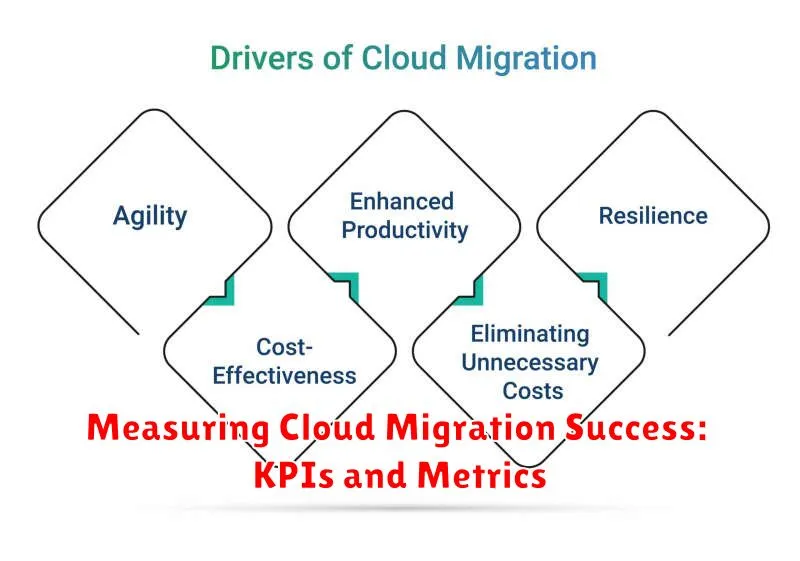
Migrating to the cloud is a significant undertaking, promising numerous benefits like enhanced agility, scalability, and cost optimization. However, measuring the success of your cloud migration is crucial to ensure that you’re reaping the expected rewards. This involves establishing clear key performance indicators (KPIs) and metrics that track your progress and highlight areas for improvement. Here are some essential metrics to monitor:
Cost Optimization:
- Total Cost of Ownership (TCO): Compare pre-migration costs with post-migration expenses to assess cost savings.
- Cloud Spend Optimization: Analyze cloud service utilization and identify opportunities to reduce unnecessary spending.
Performance and Availability:
- Application Response Time: Measure the time it takes for applications to respond to user requests.
- System Uptime: Track the percentage of time your applications and services are operational.
- Network Latency: Monitor the time it takes for data to travel between different components of your cloud infrastructure.
Security and Compliance:
- Security Incidents: Track the number of security breaches and vulnerabilities detected.
- Compliance Audits: Monitor your adherence to relevant regulations and industry standards.
User Experience:
- User Satisfaction Surveys: Gather feedback from users on their experience with cloud-based services.
- Application Usage Metrics: Track the frequency and volume of application usage.
Business Agility:
- Time to Market: Measure the time it takes to deploy new applications and services.
- Deployment Frequency: Track the number of times you deploy new applications or updates to existing applications.
By diligently monitoring these KPIs, you can gain valuable insights into your cloud migration’s success, identify areas for optimization, and ensure that you’re maximizing the benefits of your cloud adoption.
Real-World Cloud Migration Success Stories
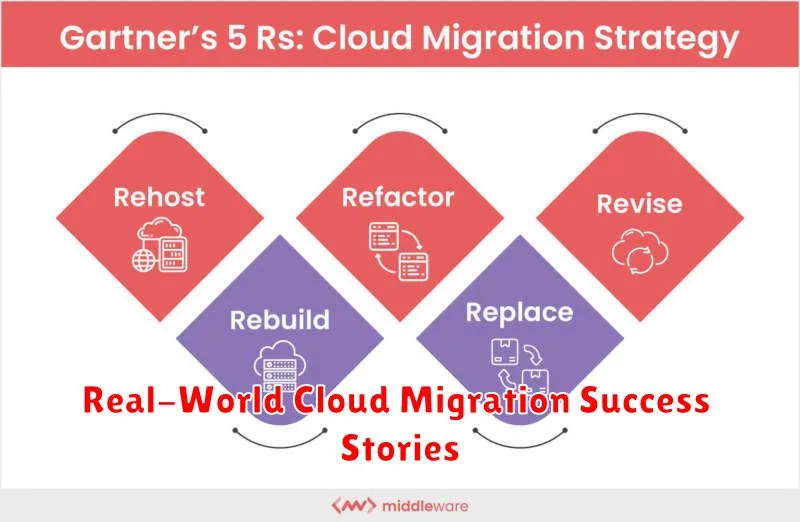
Embarking on a cloud migration journey can be daunting, but witnessing real-world success stories can provide invaluable inspiration and guidance. Here are a few examples of companies that have successfully transitioned to the cloud, unlocking significant business agility and achieving their strategic goals:
Netflix, the streaming giant, leveraged cloud computing to scale its infrastructure and deliver high-quality video content to millions of users worldwide. By migrating to AWS, they gained the flexibility to handle peak demand and deliver a seamless streaming experience, significantly improving customer satisfaction.
Spotify, the music streaming platform, adopted a multi-cloud approach, using AWS and Google Cloud to optimize performance and scalability. This strategy enabled them to expand globally, cater to diverse user needs, and rapidly innovate new features.
Salesforce, the CRM leader, built its entire platform on the cloud, achieving unprecedented agility and scalability. Their cloud-native approach allows them to deliver continuous innovation, meet evolving customer demands, and maintain a competitive edge.
These success stories demonstrate the transformative power of cloud migration. By carefully planning, executing, and optimizing their cloud strategy, these companies achieved significant benefits, including:
- Increased agility and scalability
- Enhanced performance and reliability
- Reduced IT costs
- Improved collaboration and innovation
Their journeys inspire businesses of all sizes to embrace the cloud and unlock their own potential for growth, efficiency, and competitive advantage.

